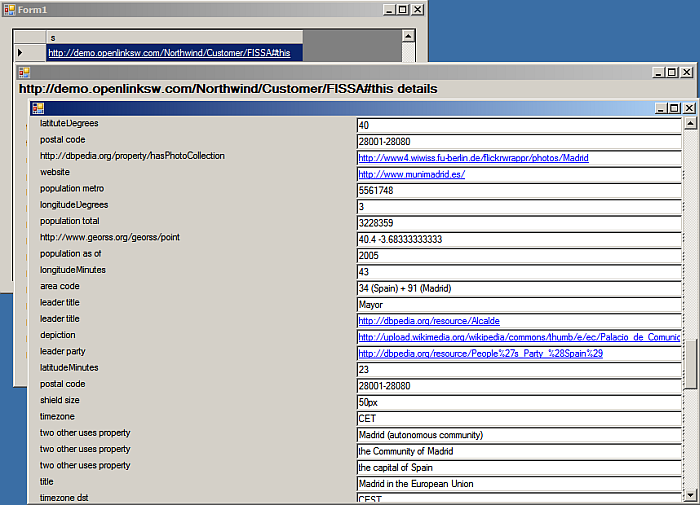2.9.4. Extending RDFDemo to Display More Compact Labels
This section will guide you through extending the application created in Extending RDFDemo to Allow Dereferencing of External IRIs so that the data is displayed in a more readable form.
Pre-requisites
-
A working copy of the RDFDemo application created in Extending RDFDemo to Allow Dereferencing of External IRIs
Extending the Application
The RDF demo application presents the user with a list of Customers from the Northwind database in the form of dereferenceable IRIs. When a customer is selected from the list the application uses a sparql query to describe that customer and the results are displayed in a form as rows of labels and data. The labels correspond to RDF predicates and the data corresponds to RDF objects while the subject is the customer initially selected. In many cases the objects are dereferencable IRIs which are then used as the subject when the 'drilling down' into the data. However, the predicates are also IRIs so it is possible to gain more information about these as well.
The RDF Schema defines a property http://www.w3.org/2000/01/rdf-schema#label that may be used to provide a human-readable version of a resource's name. We can obtain further details of each of the predicates in a resultset and check to see if one of the properties is an http://www.w3.org/2000/01/rdf-schema#label. If it is we can use the associated text as the label in our form instead of the the predicate IRI. The benefit should be a more human readable form.
Step 1 - Add a New Method to Get the Label Text
This method takes the predicate IRI and issues a sparql query to get its description. It then cycles through the returned dataset to find a http://www.w3.org/2000/01/rdf-schema#label. If there is one then the associated text is returned by the method. Otherwise the method returns the IRI string.
-
Add the following method to the ExtendedStringHandlerClass
private string getLabelText(Object label) { string labelText = label.ToString(); if (label is SqlExtendedString) { SqlExtendedString se = (SqlExtendedString)label; StringBuilder getLabelCommandText = new StringBuilder("sparql define get:soft \"soft\" select * from <" + se.ToString() + "> where {<" + se.ToString() + "> ?p ?o}"); VirtuosoCommand getLabelCommand = new VirtuosoCommand(getLabelCommandText.ToString(), ParentConnection); VirtuosoDataAdapter getLabelAdapter = new VirtuosoDataAdapter(); getLabelAdapter.SelectCommand = getLabelCommand; DataSet getLabelDataSet = new DataSet(); try { getLabelAdapter.Fill(getLabelDataSet); foreach (DataRow getLabelRow in getLabelDataSet.Tables[0].Rows) { if (getLabelRow[0].ToString() == "http://www.w3.org/2000/01/rdf-schema#label") { labelText = getLabelRow[1].ToString(); break; } } } catch { } } return labelText; } -
Change the line in displayData from
propertyLabel.Text = row[0].ToString();
-
to
propertyLabel.Text = getLabelText(row[0]);
Step 1 - Add a New Method to Get the Label Text
When you run the application you will see that the initial form is the same. In fact, when you select the Customer you will also see that the customer details are also the same. It is only when you start exploring data outside the Northwind graph that you will see the labels in the form change.
Figure 2.149. Northwind graph

Next Steps
It is clear from running the application that the Northwind ontology does not define an http://www.w3.org/2000/01/rdf-schema#label for its members. In order to benefit from this modified version of RDFDemo we need to update our Northwind ontology so that http://www.w3.org/2000/01/rdf-schema#label is defined for each resource. The next step will be to modify our Northwind ontology.
